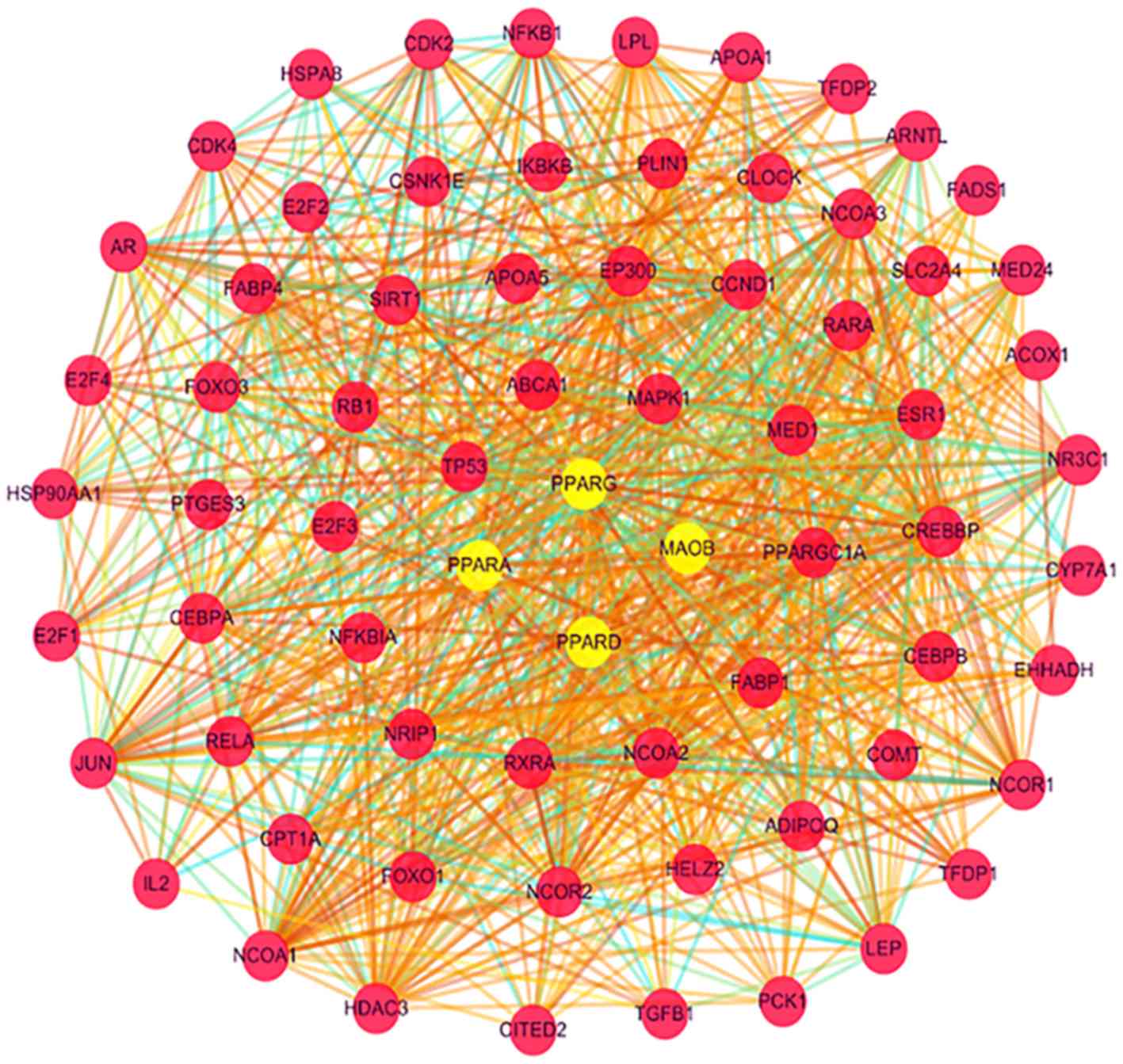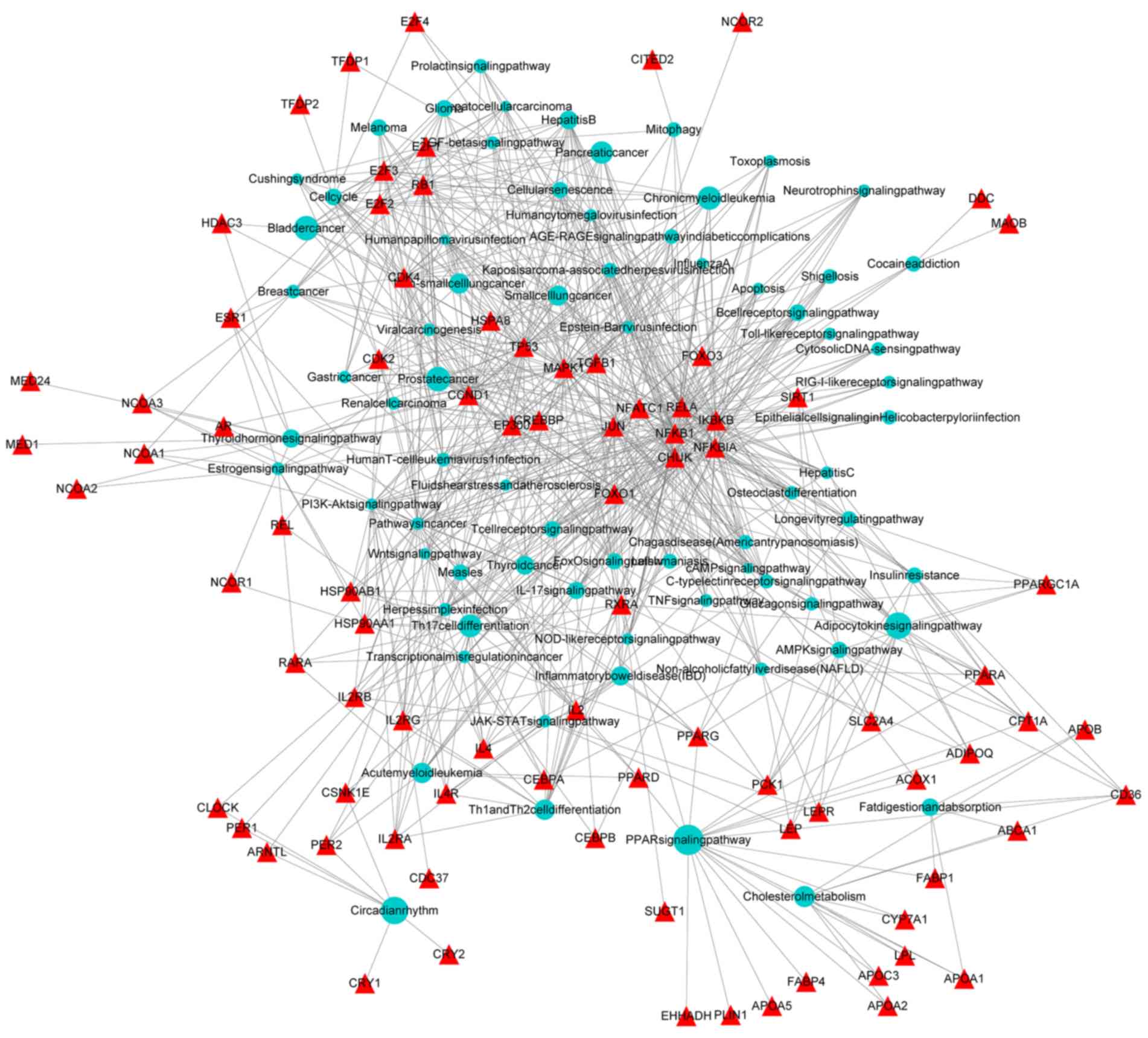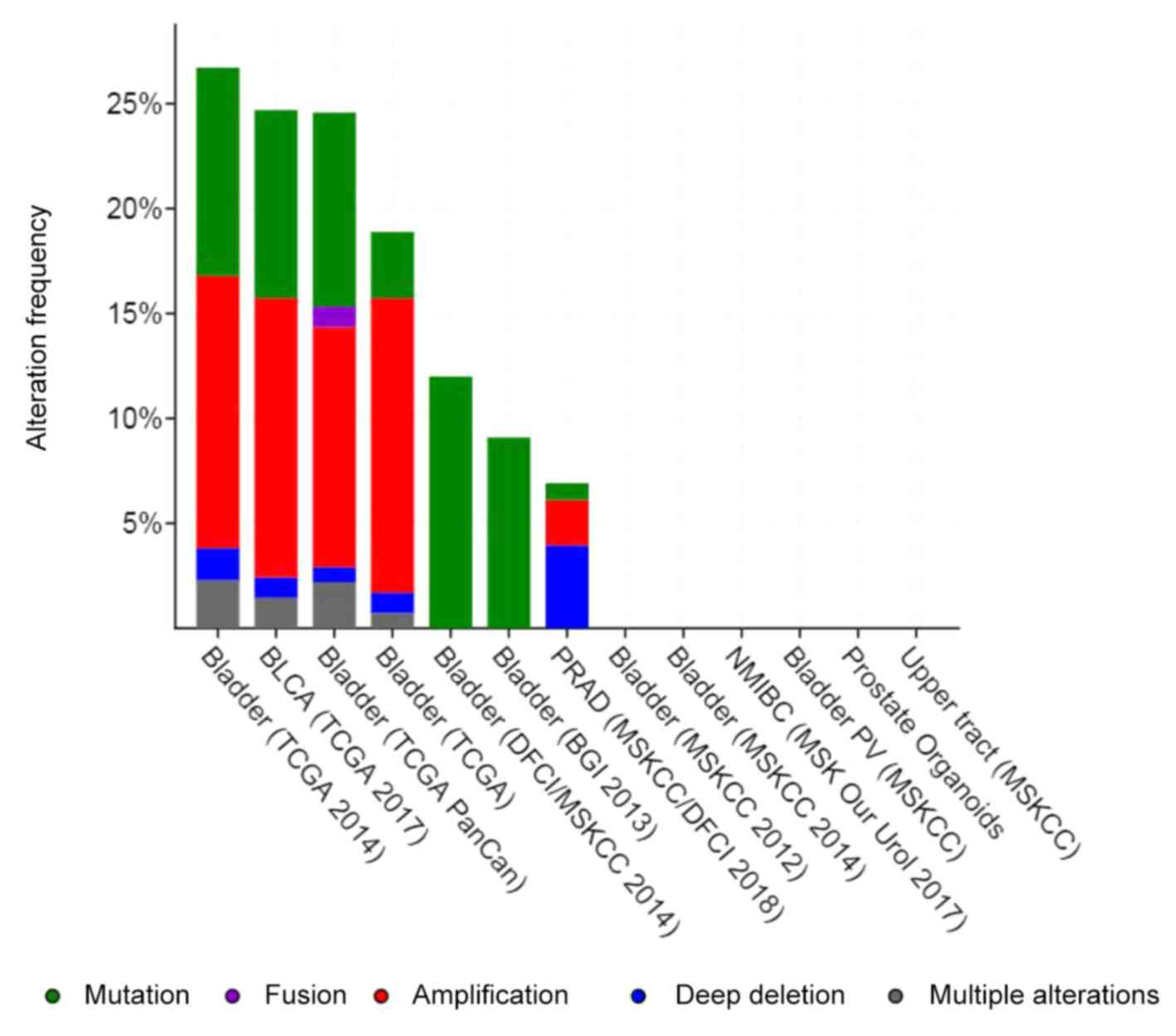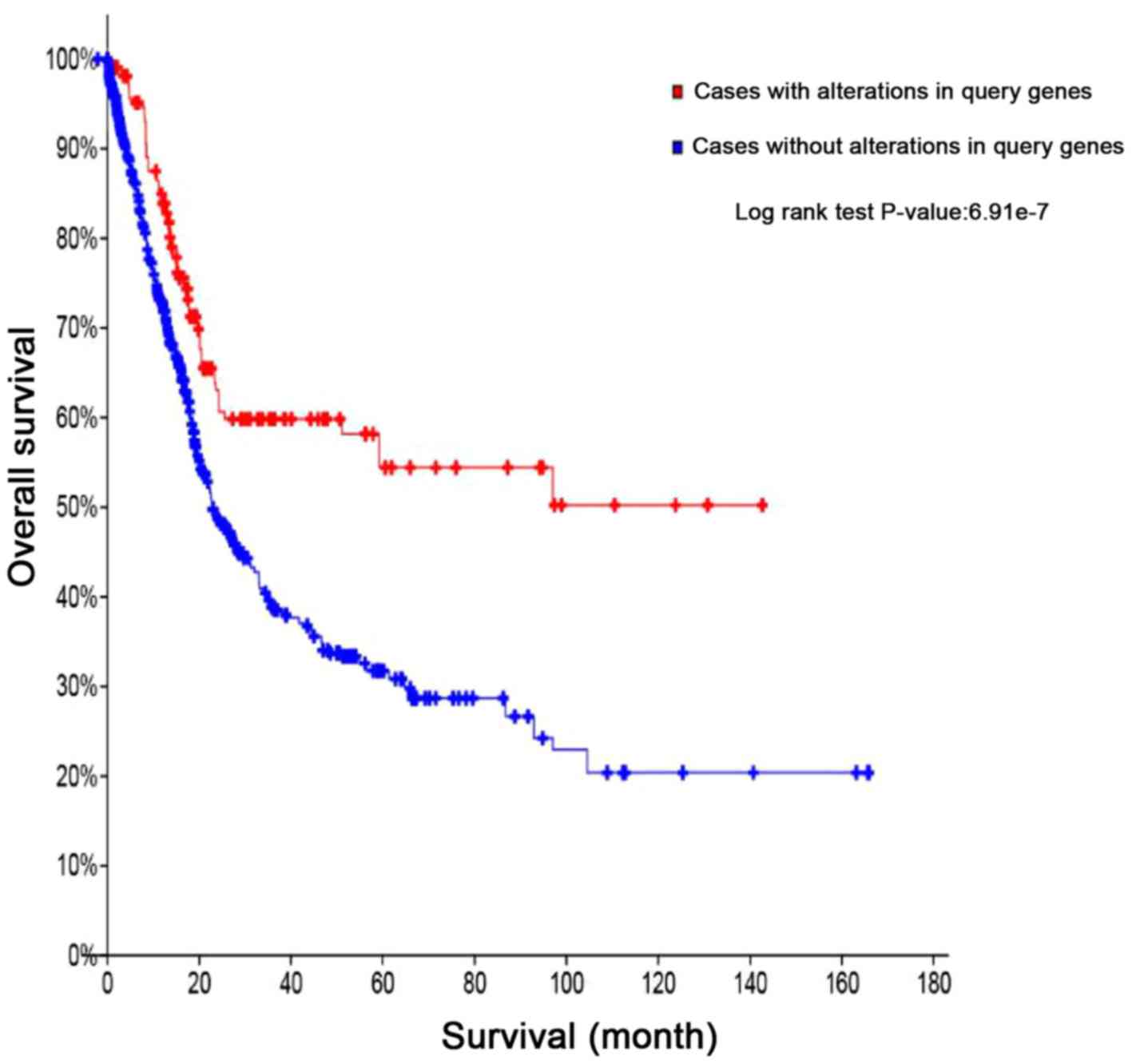|
1
|
Mylona E, Giannopoulou I, Diamantopoulou
K, Bakarakos P, Nomikos A, Zervas A and Nakopoulou L: Peroxisome
proliferator-activated receptor gamma expression in urothelial
carcinomas of the bladder: Association with differentiation,
proliferation and clinical outcome. Eur J Surg Oncol. 35:197–201.
2009. View Article : Google Scholar : PubMed/NCBI
|
|
2
|
Kemnitz JW, Elson DF, Roecker EB, Baum ST,
Bergman RN and Meglasson MD: Pioglitazone increases insulin
sensitivity, reduces blood glucose, insulin, and lipid levels, and
lowers blood pressure, in obese, insulin-resistant rhesus monkeys.
Diabetes. 43:204–211. 1994. View Article : Google Scholar : PubMed/NCBI
|
|
3
|
Miller JL: FDA approves pioglitazone for
diabetes. Am J Health Syst Pharm. 56:16981999. View Article : Google Scholar : PubMed/NCBI
|
|
4
|
Dormandy JA, Charbonnel B, Eckland DJ,
Erdmann E, Massi-Benedetti M, Moules IK, Skene AM, Tan MH, Lefèbvre
PJ, Murray GD, et al: Secondary prevention of macrovascular events
in patients with type 2 diabetes in the PROactive Study
(PROspective pioglitAzone Clinical Trial in MacroVascular Events):
A randomised controlled trial. Lancet. 366:1279–1289. 2005.
View Article : Google Scholar : PubMed/NCBI
|
|
5
|
Marx N, Duez H, Fruchart JC and Staels B:
Peroxisome proliferators-activated receptors and atherogenesis:
Regulators of gene expression in vascular cells. Circ Res.
94:1168–1178. 2004. View Article : Google Scholar : PubMed/NCBI
|
|
6
|
van Wijk JP and Rabelink TJ: Impact of
thiazolidinedione therapy on atherogenesis. Curr Atheroscler Rep.
7:369–374. 2005. View Article : Google Scholar : PubMed/NCBI
|
|
7
|
Hernández-Valencia M, Hernández-Rosas M
and Zárate A: Care of insulin resistance in polycystic ovary
syndrome. Ginecol Obstet Mex. 78:612–616. 2010.(In Spanish).
PubMed/NCBI
|
|
8
|
Lewis JD, Ferrara A, Peng T, Hedderson M,
Bilker WB, Quesenberry CP Jr, Vaughn DJ, Nessel L, Selby J and
Strom BL: Risk of bladder cancer among diabetic patients treated
with pioglitazone: Interim report of a longitudinal cohort study.
Diabetes Care. 34:916–922. 2011. View Article : Google Scholar : PubMed/NCBI
|
|
9
|
Neumann A, Weill A, Ricordeau P, Fagot JP,
Alla F and Allemand H: Pioglitazone and risk of bladder cancer
among diabetic patients in France: A population-based cohort study.
Diabetologia. 55:1953–1962. 2012. View Article : Google Scholar : PubMed/NCBI
|
|
10
|
Ness RW, Siol M and Barrett SC: De novo
sequence assembly and characterization of the floral transcriptome
in cross- and self-fertilizing plants. BMC Genomics. 12:2982011.
View Article : Google Scholar : PubMed/NCBI
|
|
11
|
Alagna F, D'Agostino N, Torchia L, Servili
M, Rao R, Pietrella M, Giuliano G, Chiusano ML, Baldoni L and
Perrotta G: Comparative 454 pyrosequencing of transcripts from two
olive genotypes during fruit development. BMC Genomics. 10:3992009.
View Article : Google Scholar : PubMed/NCBI
|
|
12
|
Severin AJ, Woody JL, Bolon YT, Joseph B,
Diers BW, Farmer AD, Muehlbauer GJ, Nelson RT, Grant D, Specht JE,
et al: RNA-Seq Atlas of Glycine Max: A guide to the soybean
transcriptome. BMC Plant Biol. 10:1602010. View Article : Google Scholar : PubMed/NCBI
|
|
13
|
Morrissy AS, Morin RD, Delaney A, Zeng T,
McDonald H, Jones S, Zhao Y, Hirst M and Marra MA: Next-generation
tag sequencing for cancer gene expression profiling. Genome Res.
19:1825–1835. 2009. View Article : Google Scholar : PubMed/NCBI
|
|
14
|
Barabási AL and Oltvai ZN: Network
biology: Understanding the cell's functional organization. Nat Rev
Genet. 5:101–113. 2004. View
Article : Google Scholar : PubMed/NCBI
|
|
15
|
Barabási AL, Gulbahce N and Loscalzo J:
Network medicine: A network-based approach to human disease. Nat
Rev Genet. 12:56–68. 2011. View
Article : Google Scholar : PubMed/NCBI
|
|
16
|
Sun J, Wu Y, Xu H and Zhao Z: DTome: A
web-based tool for drug-target interactome construction. BMC
Bioinformatics. 13 (Suppl 9):S72012. View Article : Google Scholar : PubMed/NCBI
|
|
17
|
Law V, Knox C, Djoumbou Y, Jewison T, Guo
AC, Liu Y, Maciejewski A, Arndt D, Wilson M, Neveu V, et al:
DrugBank 4.0: Shedding new light on drug metabolism. Nucleic Acids
Res. 42:D1091–D1097. 2014. View Article : Google Scholar : PubMed/NCBI
|
|
18
|
Szklarczyk D, Morris JH, Cook H, Kuhn M,
Wyder S, Simonovic M, Santos A, Doncheva NT, Roth A, Bork P, et al:
The STRING database in 2017: Quality-controlled protein-protein
association networks, made broadly accessible. Nucleic Acids Res.
45:D362–D368. 2017. View Article : Google Scholar : PubMed/NCBI
|
|
19
|
Smoot ME, Ono K, Ruscheinski J, Wang PL
and Ideker T: Cytoscape 2.8: New features for data integration and
network visualization. Bioinformatics. 27:431–432. 2011. View Article : Google Scholar : PubMed/NCBI
|
|
20
|
Cerami E, Gao J, Dogrusoz U, Gross BE,
Sumer SO, Aksoy BA, Jacobsen A, Byrne CJ, Heuer ML, Larsson E, et
al: The cBio cancer genomics portal: An open platform for exploring
multidimensional cancer genomics data. Cancer Discov. 2:401–404.
2012. View Article : Google Scholar : PubMed/NCBI
|
|
21
|
Gao J, Aksoy BA, Dogrusoz U, Dresdner G,
Gross B, Sumer SO, Sun Y, Jacobsen A, Sinha R, Larsson E, et al:
Integrative analysis of complex cancer genomics and clinical
profiles using the cBioPortal. Sci Signal. 6:pl12013. View Article : Google Scholar : PubMed/NCBI
|
|
22
|
Jackson L, Wahli W, Michalik L, Watson SA,
Morris T, Anderton K, Bell DR, Smith JA, Hawkey CJ and Bennett AJ:
Potential role for peroxisome proliferator activated receptor
(PPAR) in preventing colon cancer. Gut. 52:1317–1322. 2003.
View Article : Google Scholar : PubMed/NCBI
|
|
23
|
Kawa S, Nikaido T, Unno H, Usuda N,
Nakayama K and Kiyosawa K: Growth inhibition and differentiation of
pancreatic cancer cell lines by PPAR gamma ligand troglitazone.
Pancreas. 24:1–7. 2002. View Article : Google Scholar : PubMed/NCBI
|
|
24
|
Chang TH and Szabo E: Induction of
differentiation and apoptosis by ligands of peroxisome
proliferator-activated receptor gamma in non-small cell lung
cancer. Cancer Res. 60:1129–1138. 2000.PubMed/NCBI
|
|
25
|
Kikuchi A, Kishida S and Yamamoto H:
Regulation of Wnt signaling by protein-protein interaction and
post-translational modifications. Exp Mol Med. 38:1–10. 2006.
View Article : Google Scholar : PubMed/NCBI
|
|
26
|
Kim PH, Cha EK, Sfakianos JP, Iyer G,
Zabor EC, Scott SN, Ostrovnaya I, Ramirez R, Sun A, Shah R, et al:
Genomic predictors of survival in patients with high-grade
urothelial carcinoma of the bladder. Eur Urol. 67:198–201. 2015.
View Article : Google Scholar : PubMed/NCBI
|
|
27
|
Iyer G, Al-Ahmadie H, Schultz N, Hanrahan
AJ, Ostrovnaya I, Balar AV, Kim PH, Lin O, Weinhold N, Sander C, et
al: Prevalence and co-occurrence of actionable genomic alterations
in high-grade bladder cancer. J Clin Oncol. 31:3133–3140. 2013.
View Article : Google Scholar : PubMed/NCBI
|
|
28
|
Robertson AG, Kim J, Al-Ahmadie H,
Bellmunt J, Guo G, Cherniack AD, Hinoue T, Laird PW, Hoadley KA,
Akbani R, et al: Comprehensive molecular characterization of
muscle-invasive bladder cancer. Cell. 171:540.e25–556.e25. 2017.
View Article : Google Scholar
|
|
29
|
Al-Ahmadie HA, Iyer G, Lee BH, Scott SN,
Mehra R, Bagrodia A, Jordan EJ, Gao SP, Ramirez R, Cha EK, et al:
Frequent somatic CDH1 loss-of-function mutations in plasmacytoid
variant bladder cancer. Nat Genet. 48:356–358. 2016. View Article : Google Scholar : PubMed/NCBI
|
|
30
|
Guo G, Sun X, Chen C, Wu S, Huang P, Li Z,
Dean M, Huang Y, Jia W, Zhou Q, et al: Whole-genome and whole-exome
sequencing of bladder cancer identifies frequent alterations in
genes involved in sister chromatid cohesion and segregation. Nat
Genet. 45:1459–1463. 2013. View
Article : Google Scholar : PubMed/NCBI
|
|
31
|
Cancer Genome Atlas Research Network, .
Comprehensive molecular characterization of urothelial bladder
carcinoma. Nature. 507:315–322. 2014. View Article : Google Scholar : PubMed/NCBI
|
|
32
|
Pietzak EJ, Bagrodia A, Cha EK, Drill EN,
Iyer G, Isharwal S, Ostrovnaya I, Baez P, Li Q, Berger MF, et al:
Next-generation sequencing of nonmuscle invasive bladder cancer
reveals potential biomarkers and rational therapeutic targets. Eur
Urol. 72:952–959. 2017. View Article : Google Scholar : PubMed/NCBI
|
|
33
|
Van Allen EM, Mouw KW, Kim P, Iyer G,
Wagle N, Al-Ahmadie H, Zhu C, Ostrovnaya I, Kryukov GV, O'Connor
KW, et al: Somatic ERCC2 mutations correlate with cisplatin
sensitivity in muscle-invasive urothelial carcinoma. Cancer Discov.
4:1140–1153. 2014. View Article : Google Scholar : PubMed/NCBI
|
|
34
|
Faltas BM, Prandi D, Tagawa ST, Molina AM,
Nanus DM, Sternberg C, Rosenberg J, Mosquera JM, Robinson B,
Elemento O, et al: Clonal evolution of chemotherapy-resistant
urothelial carcinoma. Nat Genet. 48:1490–1499. 2016. View Article : Google Scholar : PubMed/NCBI
|
|
35
|
Hoadley KA, Yau C, Hinoue T, Wolf DM,
Lazar AJ, Drill E, Shen R, Taylor AM, Cherniack AD, Thorsson V, et
al: Cell-of-origin patterns dominate the molecular classification
of 10,000 tumors from 33 types of cancer. Cell. 173:291.e6–304.e6.
2018. View Article : Google Scholar
|
|
36
|
Tang H, Shi W, Fu S, Wang T, Zhai S, Song
Y and Han J: Pioglitazone and bladder cancer risk: A systematic
review and meta-analysis. Cancer Med. 7:1070–1080. 2018. View Article : Google Scholar : PubMed/NCBI
|
|
37
|
Isabelle N. Colmer, Samantha L. Bowker, et
al: Pioglitazone and bladder cancer risk: A systematic review and
meta-analysis. CMAJ. 184:E675–E683. 2012.PubMed/NCBI
|
|
38
|
Guan Y, Zhang Y, Davis L and Breyer MD:
Expression of peroxisome proliferator-activated receptors in
urinary tract of rabbits and humans. Am J Physiol. 273:F1013–F1022.
1997.PubMed/NCBI
|
|
39
|
Bojková B, Orendáš P, Kubatka P, Péč M,
Kassayová M, Kisková T and Kajo K: Positive and negative effects of
glitazones in carcinogenesis: Experimental models vs. clinical
practice. Pathol Res Pract. 210:465–472. 2014. View Article : Google Scholar : PubMed/NCBI
|
|
40
|
Bishop-Bailey D and Warner TD: PPARgamma
ligands induce prostaglandin production in vascular smooth muscle
cells: Indomethacin acts as a peroxisome proliferator-activated
receptor-gamma antagonist. FASEB J. 17:1925–1927. 2003. View Article : Google Scholar : PubMed/NCBI
|
|
41
|
Sato K, Awasaki Y, Kandori H, Tanakamaru
ZY, Nagai H, Baron D and Yamamoto M: Suppressive effects of
acid-forming diet against the tumorigenic potential of pioglitazone
hydrochloride in the urinary bladder of male rats. Toxicol Appl
Pharmacol. 251:234–244. 2011. View Article : Google Scholar : PubMed/NCBI
|
|
42
|
Suzuki S, Arnold LL, Pennington KL,
Kakiuchi-Kiyota S, Wei M, Wanibuchi H and Cohen SM: Effects of
pioglitazone, a peroxisome proliferator-activated receptor gamma
agonist, on the urine and urothelium of the rat. Toxicol Sci.
113:349–357. 2010. View Article : Google Scholar : PubMed/NCBI
|
|
43
|
Halstead AM, Kapadia CD, Bolzenius J, Chu
CE, Schriefer A, Wartman LD, Bowman GR and Arora VK:
Bladder-cancer-associated mutations in RXRA activate peroxisome
proliferator-activated receptors to drive urothelial proliferation.
Elife. 6:2017. View Article : Google Scholar : PubMed/NCBI
|
|
44
|
Rhodes DR, Yu J, Shanker K, Deshpande N,
Varambally R, Ghosh D, Barrette T, Pandey A and Chinnaiyan AM:
ONCOMINE: A cancer microarray database and integrated data-mining
platform. Neoplasia. 6:1–6. 2004. View Article : Google Scholar : PubMed/NCBI
|
|
45
|
Rhodes DR, Kalyana-Sundaram S, Mahavisno
V, Varambally R, Yu J, Briggs BB, Barrette TR, Anstet MJ,
Kincead-Beal C, Kulkarni P, et al: Oncomine 3.0: Genes, pathways,
and networks in a collection of 18,000 cancer gene expression
profiles. Neoplasia. 9:166–180. 2007. View Article : Google Scholar : PubMed/NCBI
|
|
46
|
Gottlieb A, Stein GY, Ruppin E and Sharan
R: PREDICT: A method for inferring novel drug indications with
application to personalized medicine. Mol Syst Biol. 7:4962011.
View Article : Google Scholar : PubMed/NCBI
|
|
47
|
Devchand PR, Liu T, Altman RB, FitzGerald
GA and Schadt EE: The pioglitazone trek via human PPAR Gamma: From
discovery to a medicine at the FDA and beyond. Front Pharmacol.
9:10932018. View Article : Google Scholar : PubMed/NCBI
|
|
48
|
Wen W, Wu P, Gong J, Zhao M, Zhang Z, Chen
R, Chen H and Sun J: Association of pioglitazone with increased
risk of prostate cancer and pancreatic cancer: A functional network
study. Diabetes Ther. 9:2229–2243. 2018. View Article : Google Scholar : PubMed/NCBI
|
|
49
|
Yang SL, Wang JJ, Chen M, Xu L, Li N, Luo
YL, Bu L, Zhang MN, Li H and Su BL: Pioglitazone use and risk of
bladder cancer: An in vitro study. Int J Med Sci. 15:228–237. 2018.
View Article : Google Scholar : PubMed/NCBI
|
|
50
|
Lv S, Wang W, Wang H, Zhu Y and Lei C:
PPARγ activation serves as therapeutic strategy against bladder
cancer via inhibiting PI3K-Akt signaling pathway. BMC Cancer.
19:2042019. View Article : Google Scholar : PubMed/NCBI
|



















